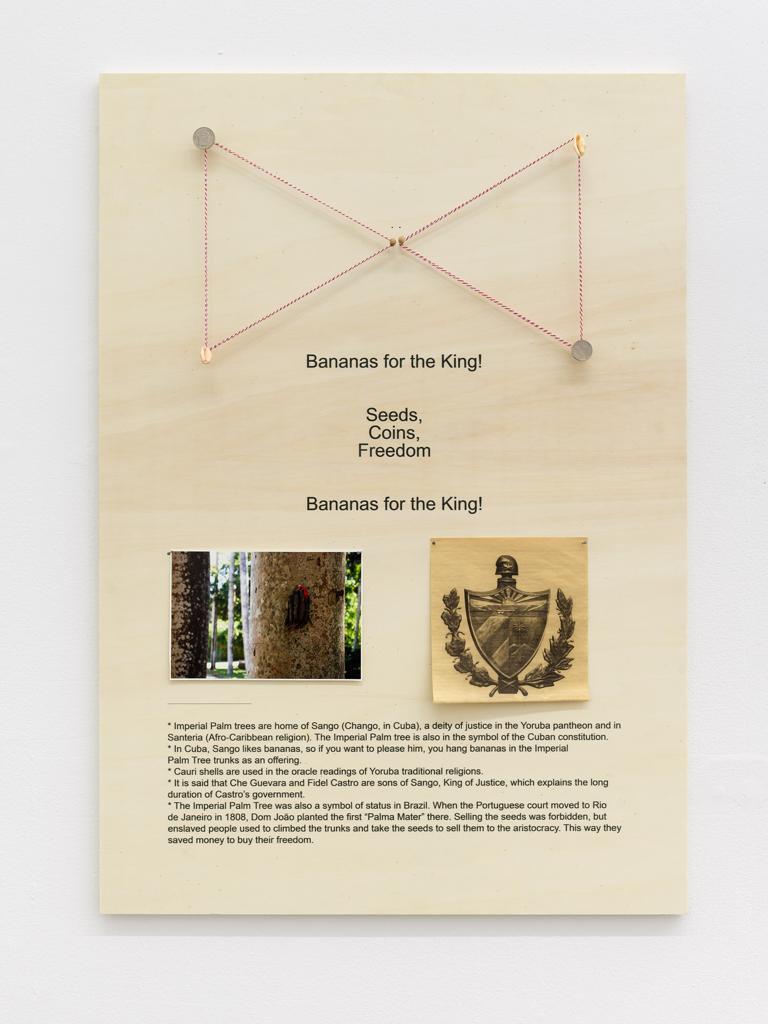Acquisition of artwork for ESCALA – Essex Collection of Art from Latin America
Ana Hupe Footnotes to a triangular cartography (2019)




In a format that alludes to school books and classic displays of ethnography museums, each of the three main panels that composes Ana Hupe’s Notas de rodapé para uma cartografia triangular [Footnotes for a triangular cartography] presents a correspondence between three elements. Each panel is associated to one Orisha, deities of the Yoruba culture (Yemanjá, Sango and Osun); to one place (Brazil, Cuba and Nigeria); and to broad references of the history of colonisation, the Atlantic slave trade, and the shaping of the Afro-Diasporic identity.
The use of a system of correspondence suggests a Western framework of philosophical thought and systems of knowledge. However, the work also expands from such a notion insofar as it presents historical references in a style that appears to be analytical but whose organisation is, in fact, guided by the artist’s personal experiences and free associations. As it is customary for the artist, these free associations approximate historical research to a universe of less stringent possibilities – that of the visual arts.
Whilst each panel brings its own footnotes contextualising and correlating the elements of its triangle, the entire artwork also contains a footnote of its own. The fourth wooden panel that composes the piece reads “The continuation of the world depends on our ability to revive beings and seemingly lifeless things.” In the call to revive beings and things, the sentence – inspired by ideas of Cameroon intellectual Achille Mbembe – binds the stories, elements and characters presented across all panels through one same notion that is recurrent through the work: the urgency to rescue values (rooted in the Yoruba culture just as in the Indigenous cultures of Latin America) which approach nature with a sense of sovereignty that opposes the predatory approach imposed by colonising cultures.
In Yoruba culture, natural elements and spaces such as rivers, forests and lands are deities, and are regarded with the same sovereignty attributed to spiritual entities. The work’s footnote suggests treating the environment as interconnected with one's own existence, the premise of a concept that, across Indigenous cultures, is largely recognised as cosmovision.
The notion of cosmovision is reiterated by one of the elements of the second panel – the page of a school book which, aimed at teaching kids the Yoruba language, does not contain a single word. This approach to learning, as well as to language itself, highlights traces of a culture regulated by a set of values and precepts dramatically different from the Europe-originated.
The foundations on which those cultures were shaped are different, and their explanation to an external gaze requires several footnotes.
Notas de rodapé para uma cartografia triangular is the result of a research initiated in Bahia, Brazil, when Hupe participated in the Artistic Residence Vila Sul organised by the Goethe-Institut Brasil, between April - June 2018. Branching out from the same research, additional works were later created and the wider series is now named after the same title, only, then, plural: res [Footnotes for triangular cartographies]. References which were fundamental for the creation of this seminal piece are further expanded and unfolded in the later works. The research that overarches the series is currently in the process of becoming a book, expected to be published by the end of 2021.
While the creation of this piece was inspired by the earlier artistic residence, it was only at a later stage – and within a new context – that the artwork’s key element was incorporated: the footnote. Notas de rodapé para uma cartografia triangular was finally conceived in light of Hupe’s artistic residence at the Goldrausch, in Berlin, in 2019.
For the artist, the piece is as a response to her personal experience of having integrated the German programme as the only Latin American in the group, as well as to her broader perspective as a Latin American artist with a research-based practice whose outcome work presumably requires lengthy historical and cultural contextualisation. In the artist's words: “If I was going to show this work in Brazil, I would remove the footnotes because they are not necessary (...) but, here, for this social context, I found them important”.
Stemming from this principle, the footnotes have become the core of this artwork, responding to the issues of how to both address and display matters that are so intrinsic to a non-European culture within a European context.
Ana Hupe
Notas de rodapé para uma cartografia triangular [Footnotes to a triangular cartography], 2019
3 wooden plates 70 x 100cm + 1 wooden plate 180 x 10cm
1. Bananas for the King!
70 x 100 cm wood 18mm, UV Print on Wood
2 metal triangles, 2 cauris, 2 coins "pesos cubanos", 2 seeds of Imperial Palm Tree, page of the Cuban Constitution + Photograph C-Print color
2. The state of the living spring
70 x 100 cm wood 18mm, UV Print on Wood
Photograph C-Print color, stone from Osun River, Osogbo, Nigeria, cauri, page of a book
3. Europe, Iyemojá and Zumbi
70 x 100 cm wood 18mm, UV Print on Wood
1 elastic triangle, 1 Photograph C-Print Color, 2 silk-screens of Moon Europa 30 x 30cm.
4. Footnote "The continuation of the world depends on our ability to revive beings and seemingly lifeless things" (inspired by Achille Mbembe’s ideas)
UV Print on Wood plate 180 x 10 cm
[“The continuation of the world depends on our ability to revive beings and seemingly lifeless things”]